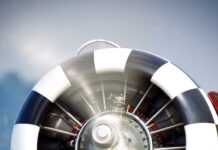With much of the safety emphasis and concerns directed towards the movement of aircraft, static aircraft are easily overlooked. But the static display area needs your attention, too. Here are a few things to consider:
* Static display aircraft should have at least one grounding wire (as a minimum) at all times. In the event that an aircraft has an external power unit in use for displaying onboard electrical equipment, two grounding wires should be used. It is also recommended that the power unit have plastic marker cones situated in close proximity to the unit with signs that indicate high noise levels are present within the confines of the cones.
* Aircraft with external power should have two exits from the aircraft established while electrical power is applied to the aircraft. It is recommended that a qualified crew member be on board the aircraft and positioned to turn off electrical power if an emergency occurs.
* Engine intake plugs should be installed whenever possible.
* Aircraft with reciprocating engines should have the propeller blades positioned in such a way that they do not pose a hazard to spectators viewing the aircraft.
* If an airplane is not roped off so that people are able to get an up-close look, consider placing cones with reflectors on the ground at the wingtips, nose and tail of the aircraft to keep people from walking into or, more likely, driving too close to the parked aircraft.
* When planning your static lay-out and especially if you are not towing your statics into position, be sure to consider the consequences of prop wash, jet wash and rotor wash for both arriving and departing aircraft.
* Anyone and everyone who has authorization to drive on the ramp in a car, truck or golf cart should be told specifically and explicitly that they are prohibited from driving under the wing of any aircraft on the ramp
* No smoking signs should be easily seen inside and throughout the static display area.
* Portable fire extinguishing bottles designed for flightline operations should be strategically positioned near the aircraft within the viewing areas.
* Static display crews need to stay hydrated while at their respective aircraft.
* If maintenance stands are used to view the aircraft, it is recommended that it be fitted with a “brace” which restricts the lowering of the stand. This will prevent serious injuries to hands and feet.
* Trash receptacles should be located in the static display area to assist in reducing potential foreign object debris (FOD) on the flightline.
* Driving of vehicles within the static display area should be strictly limited to a minimum with the exception of medical crews and security personnel.
* Roaming security personnel should make themselves visible in the static display area as frequently as possible.








